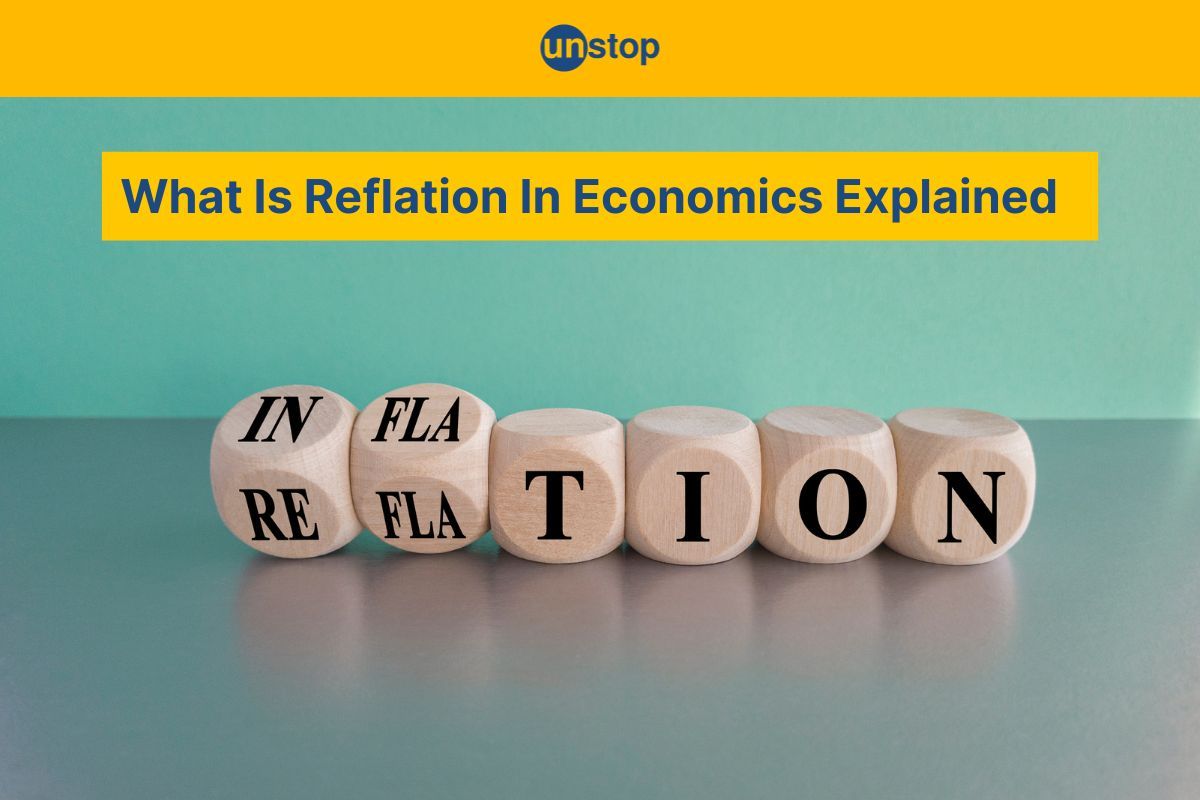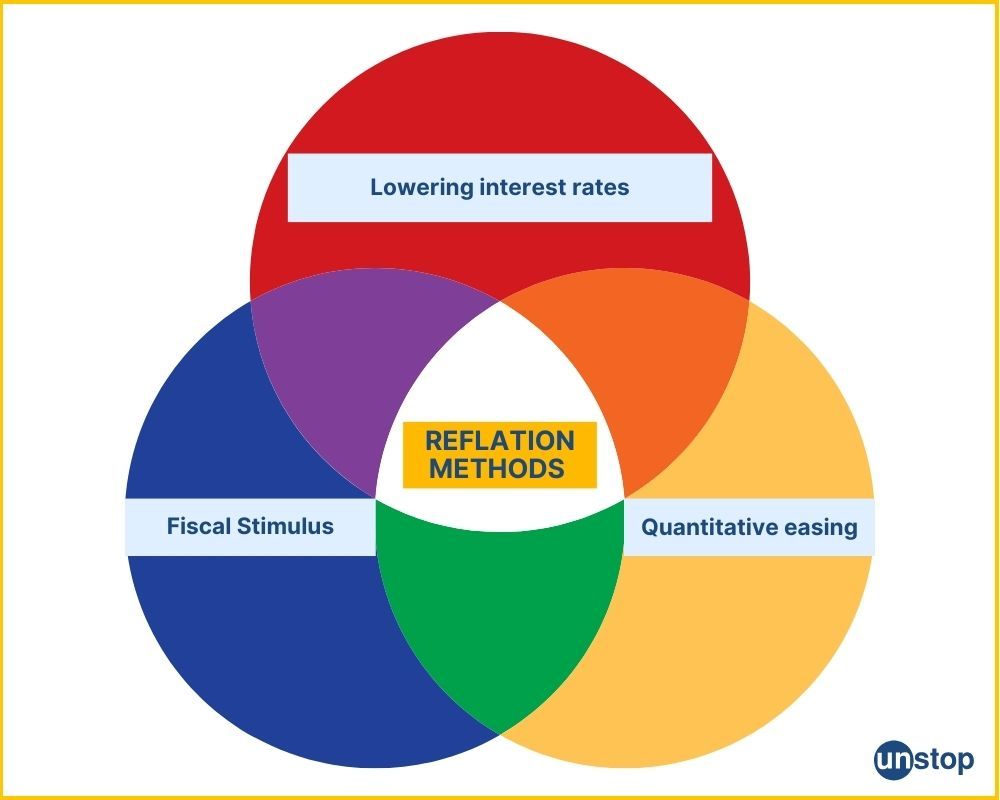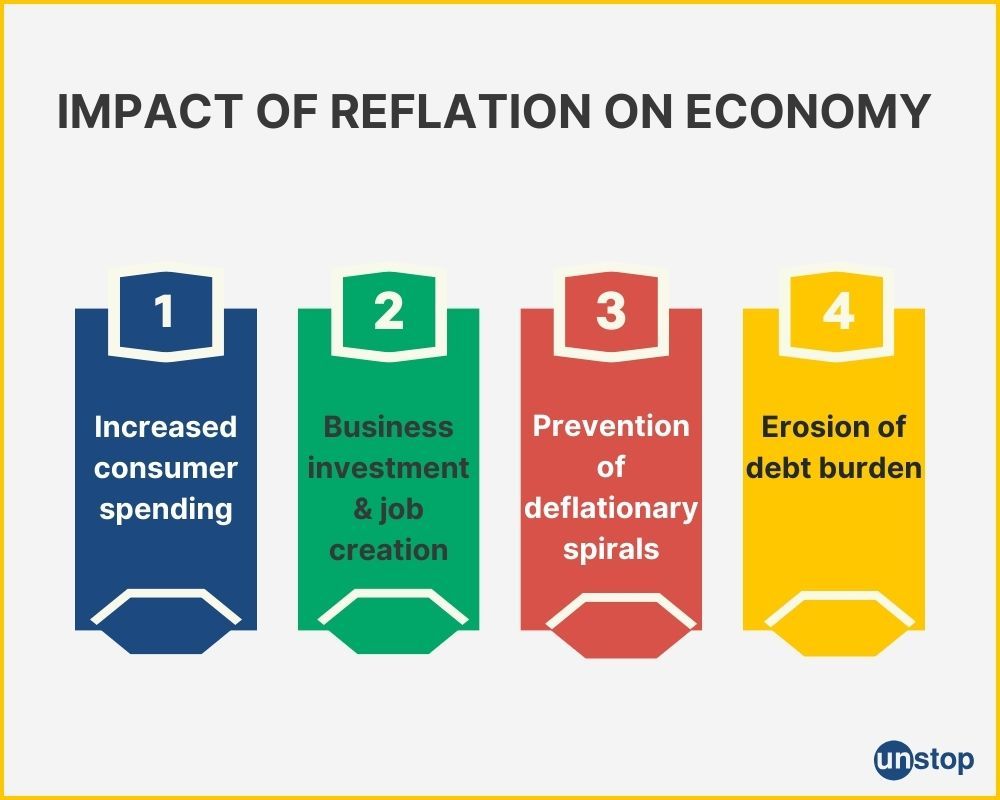- Definition Of Reflation & Its Role As Monetary Policy
- Methods & Strategies Of Reflation
- Economic Impact Of Reflation
- Real-life Examples Of Reflation
- Inflation Vs Reflation
- Frequently Asked Questions (FAQs)
- Reflation Knowledge Check Quiz – Are You Ready?
Reflation: Definition, Methods, Impact & Inflation Explained

During a reflation phase, central banks may lower interest rates, governments increase spending on infrastructure projects, and firms invest in expansion and hiring more labor. These actions are intended to stimulate demand and increase supply in the economy. Governments may issue bonds or securities to fund their stimulus efforts.
The term "reflation trade" refers to the strategy of investing in assets that benefit from a period of reflation. This approach gained prominence following the Great Recession as governments worldwide implemented stimulus measures to counteract the economic downturn.
Definition Of Reflation & Its Role As Monetary Policy
Reflation, a term often used in economics, refers to the implementation of measures aimed at stimulating economic growth and increasing inflation levels. Reflation as a monetary policy refers to the actions taken by central banks to increase the money supply and stimulate economic activity. This can be achieved through interest rate cuts, quantitative easing, or other measures that encourage borrowing and spending. The goal is to create inflationary pressure and promote economic growth.
Reflationary Policies In Central Banks
By reducing the cost of borrowing, individuals and businesses are incentivized to take out loans for investment or consumption purposes. This increased spending stimulates economic activity and encourages growth. Another tool used in reflationary policies is quantitative easing (QE). In QE, central banks purchase government bonds or other financial assets from commercial banks, injecting money into the economy. This increases liquidity in the banking system and provides additional funds for lending and investment.
Stimulating Economic Activity
The purpose of implementing reflationary policies is to stimulate economic activity during periods of low growth or recession. By increasing the money supply, central banks aim to boost consumer spending, business investment, and overall demand in the economy. When consumers have more money available due to lower interest rates or increased access to credit, they are more likely to make purchases. This leads to an increase in demand for goods and services driving up prices – a key component of inflation. Businesses may feel more confident about investing in new projects or expanding their operations when they have access to cheaper credit. This can lead to job creation, increased production capacity, and higher levels of economic output.
Methods & Strategies Of Reflation
Reflation policies are important tools that central banks employ to stimulate economic growth and combat deflationary pressures. These policies involve a range of actions, programs, and services aimed at boosting aggregate demand and increasing inflation levels. Let's explore some common methods and strategies used for reflation.

Lowering Interest Rates
One effective method of reflation is through the lowering of interest rates by central banks. By reducing interest rates, borrowing becomes cheaper for individuals and businesses alike. This encourages increased spending, investment, and consumption, which in turn stimulates economic activity. Lower interest rates also make it more attractive for consumers to take out loans for major purchases such as homes or cars, further bolstering demand in the economy.
Quantitative Easing
Another method utilized by central banks is quantitative easing (QE). This involves the purchase of government bonds or other assets from financial institutions by the central bank. The aim is to inject liquidity into the economy, thereby stimulating lending and investment. Through QE, central banks increase the money supply in circulation, which helps counter deflationary pressures and encourages spending.
Fiscal Stimulus
Fiscal stimulus is a strategy employed by governments to stimulate demand and promote economic growth. This can be achieved through various means, such as increased government spending on infrastructure projects or social welfare programs. Tax cuts may also be implemented to provide individuals with more disposable income that they can spend or invest back into the economy.
While these methods have their advantages in promoting reflationary measures, it's important to consider potential drawbacks as well. Let us see some of the advantages and disadvantages of reflation policies.
Advantages Of Reflation Policies
Boosts economic growth: Reflation policies help jumpstart economic activity by encouraging spending and investment.
Counters deflationary pressures: By increasing inflation levels, reflation policies mitigate the risks associated with deflation.
Supports employment: Increased economic activity often leads to job creation and reduced unemployment rates.
Disadvantages Of Reflation Policies
Inflation risk: Excessive reflation measures can potentially lead to high inflation, which may erode purchasing power and destabilize the economy.
Debt burden: Some reflation strategies, such as fiscal stimulus, involve increased government spending. This can lead to higher levels of public debt if not managed effectively.
Asset price bubbles: The injection of liquidity into the financial system through quantitative easing can lead to inflated asset prices, such as housing or stock market bubbles.
Economic Impact Of Reflation
Reflationary policies have a significant impact on the economy, leading to increased consumer spending, business investment, and job creation. These policies are designed to stimulate economic growth and prevent deflationary spirals that can hinder economic activity. Let's explore the benefits of reflation in more detail.

Increased Consumer Spending
One of the key benefits of reflation is its potential to boost consumer spending. When the economy is in a state of contraction or slow growth, people tend to hold back on their purchases due to uncertainty about the future. Reflationary measures such as tax cuts or direct cash transfers can put more money into people's pockets, encouraging them to spend. This increased consumer spending then drives up demand for goods and services, leading to an expansion in economic activity.
Business Investment & Job Creation
Reflation can also encourage businesses to invest in new projects and expand their operations. Lower interest rates, which are often implemented as part of reflationary policies, make borrowing cheaper for businesses. This makes it more attractive for companies to take out loans or access funds for investment purposes. As businesses invest in new equipment, technology, and infrastructure, they create jobs in the process. The resulting increase in employment levels contributes further to economic growth.
Prevention Of Deflationary Spirals
Deflation occurs when prices decline over time due to weak demand or excess supply leading to a vicious cycle where consumers delay purchases in anticipation of even lower prices, causing further declines in aggregate demand. Reflation helps prevent deflation by boosting prices through increased spending and investment. By stimulating demand for goods and services, reflationary policies help maintain price stability or moderate inflation levels.
Erosion Of Debt Burden
Reflation reduces the burden of debt over time. When there is inflation in the economy, the value of money decreases relative to the prices of goods and services. This means that over time, the real value of debt decreases as well. For individuals and businesses burdened with high levels of debt, reflation can provide some relief by eroding the real value of their obligations.
Real-life Examples Of Reflation
Let's take a look at some real-life examples and definitions of reflation to understand how it has been applied in different countries.
United States Quantitative Easing Programs
After the 2008 financial crisis, the United States implemented reflationary measures through quantitative easing (QE) programs. These programs involved the Federal Reserve buying in bulk quantities of government securities and bonds from banks and financial institutions. By injecting money into the economy, QE aimed to stimulate lending, boost consumer spending, and encourage investment. The first round of QE, known as QE1, was initiated in November 2008 with a focus on stabilizing financial markets. QE2 followed in November 2010 as an effort to support economic recovery by lowering long-term interest rates. QE3 was introduced in September 2012 to sustain the momentum of economic growth.
Japan's "Abenomics" Policy
In Japan, Prime Minister Shinzo Abe pursued aggressive reflation efforts as part of his economic policy known as "Abenomics." One of its primary goals was to combat deflation that had plagued the country's economy for years. The Bank of Japan implemented negative interest rates in January 2016 to encourage borrowing and spending. Massive government spending on infrastructure projects aimed at creating jobs and stimulating economic activity. The purchase of government bonds by the central bank increases the money supply and raises inflation expectations.
European Central Bank's Policies
The European Central Bank (ECB) has also adopted reflationary policies to address low inflation levels within the Eurozone. One significant approach employed by the ECB is maintaining low-interest rates across member countries. The ECB launched a bond-buying program called the Public Sector Purchase Program (PSPP) in 2015. The program involved purchasing government bonds from Eurozone countries to increase liquidity and stimulate economic growth.
While these examples highlight the implementation of reflation in different countries, it is essential to note that the effectiveness and impact of such policies can vary based on the specific economic conditions and challenges faced by each nation.
Inflation Vs Reflation
Inflation and reflation are two concepts that often get mixed up, but they actually have distinct meanings. Inflation refers to a sustained increase or rise in general price levels over time, meaning that prices for goods and services go up consistently. On the other hand, reflation focuses on reversing deflationary trends. Deflation is the opposite of inflation—it refers to a sustained decrease in general price levels.
Causes & Responses
Inflation can occur naturally as a result of supply and demand dynamics in an economy. For example, if there is high demand for a particular product but limited supply, its price may increase due to scarcity. However, inflation can also be caused by excessive money supply when central banks print more money than necessary. Reflation, on the other hand, is a deliberate policy response to stimulate economic activity. When an economy is experiencing deflation or sluggish growth, policymakers may implement reflationary measures to boost spending and investment. This could involve lowering interest rates or implementing fiscal policies such as increased government spending or tax cuts.
Objectives & Effects
The primary objective of reflation is to restore inflation and promote economic growth. By stimulating spending and investment, reflationary policies aim to increase demand for goods and services, leading to higher prices. This can have positive effects on an economy by encouraging businesses to expand production and hire more workers. In contrast, inflation can have positive and negative effects on an economy depending on its rate and duration. Ironically, moderate inflation can be beneficial as it encourages spending and investment while allowing wages to rise gradually. However, high or hyperinflation can erode purchasing power, reduce savings value, disrupt financial markets, and create uncertainty.
Central Banks' Role
Central banks play an essential role in looking after both inflation and reflation through their monetary policies. When inflation is excessively high, central banks increase the interest rates to reduce borrowing and spending, thereby cooling down the economy. Conversely, during periods of deflation or low growth, it lowers the interest rates to encourage borrowing and investment. Reflationary measures implemented by central banks are designed to stimulate economic activity and prevent prolonged periods of deflation. By lowering interest rates, central banks make it cheaper for businesses and individuals to borrow money from banks. This increased spending can help boost demand, raise prices, and ultimately reverse deflationary trends.
Conclusion
In conclusion, reflation is an essential monetary policy tool that aims to stimulate economic growth and combat deflationary pressures. By implementing various methods and strategies of reflation, such as adjusting interest rates and increasing government spending, policymakers can effectively manage inflation and promote sustainable economic development. Overall, understanding the concept of reflation allows individuals, businesses, and policymakers to navigate economic landscapes with greater insight. By staying informed about the impact of reflation on various sectors of the economy, one can make more informed decisions regarding investments, financial planning, or policy advocacy.
Frequently Asked Questions (FAQs)
1. What are some potential risks associated with reflation?
Reflation carries certain risks that need to be considered. One risk is the potential for excessive inflation if stimulus measures are not carefully managed. This could erode purchasing power and lead to higher costs for consumers and businesses alike. There is a risk of creating asset bubbles in certain sectors if easy credit conditions persist for too long without proper regulation.
2. How does reflation impact different industries?
The impact of reflation varies across industries. Some sectors may benefit from increased consumer spending due to improved economic conditions brought about by reflationary policies. For example, industries such as retail, hospitality, construction, and manufacturing may experience increased demand for their products or services. However, other sectors may face challenges during periods of reflation due to factors like rising input costs or increased competition.
3. Can reflationary policies lead to long-term economic growth?
Reflationary policies have the potential to stimulate long-term economic growth if implemented effectively. By boosting consumer spending and business investment, reflation can create a positive cycle of increased demand, job creation, and improved productivity. However, it is crucial to strike the right balance and avoid excessive inflation or unsustainable debt levels that could undermine long-term economic stability.
4. How does reflation differ from traditional monetary policy?
Reflation differs from traditional monetary policy in its focus on stimulating economic growth during periods of deflation or stagnation. While traditional monetary policy primarily aims to control inflation by adjusting interest rates, reflationary measures go beyond this objective. Reflation involves a combination of fiscal and monetary tools, such as government spending and tax cuts, alongside adjustments to interest rates aimed at reviving economic activity.
5. What role do central banks play in implementing reflationary policies?
Central banks often play a key role in implementing reflationary policies. They have the authority to adjust interest rates and influence money supply through open market operations. Central banks may also work closely with governments to coordinate fiscal stimulus measures that support reflation objectives. Their actions are guided by considerations such as price stability, employment targets, and overall economic health.
Reflation Knowledge Check Quiz – Are You Ready?
Suggested reads:
- Protectionism: Meaning, Advantages & Disadvantages Explained
- Nominal GDP Vs Real GDP: Definition, Calculation & Significance
- Difference Between CRR And SLR: Definition & Role Explained
- Types Of Economic Systems Defined & Explained With Examples
- What Is A Consumer? Types, Importance & Relation Explained
Instinctively, I fall for nature, music, humor, reading, writing, listening, traveling, observing, learning, unlearning, friendship, exercise, etc., all these from the cradle to the grave- that's ME! It's my irrefutable belief in the uniqueness of all. I'll vehemently defend your right to be your best while I expect the same from you!
Login to continue reading
And access exclusive content, personalized recommendations, and career-boosting opportunities.
Subscribe
to our newsletter
















Comments
Add comment